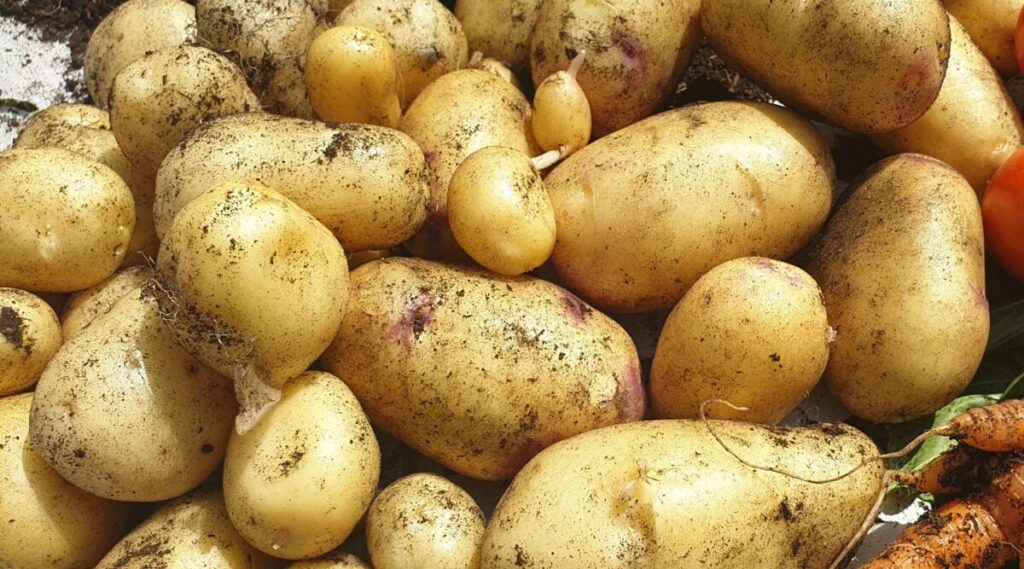Welcome to Esteelicious again, the best place for home gardening enthusiasts. Today we are venturing into the gratifying world of potato farming. With a little bit of knowledge and some right techniques, potatoes can do well in any area, from big gardens to small balconies. Let explore the ultimate guide to growing potatoes at home.
Why Potatoes?
Growing potatoes in your own garden is an excellent idea. They are not only nutritious but also quite flexible and require minimal effort for a good yield. No matter what type of potato dish you are cooking, there is always room for them on the menu. Even newbies in gardening will like working with these vegetable.
Choosing the Ideal Potato Varieties
The success of your harvest depends on choosing the right kind of potatoes . Here are a number of them:
- Early Potatoes: These varieties mature within 10-12 weeks, such as ‘Rocket’ or ‘Swift’, making them ideal for those who prefer quick crops.
- Maincrop Potatoes: On average, these take about 15-20 weeks but have relatively bigger output. Some common ones include ‘Desiree’ and ‘King Edward’.
- New Potatoes: Gently harvested when young, so that they have a tender taste for early summer dishes.
Preparing Your Garden for Planting Potatoes
For optimum growth, potatoes need loose soil that drains well enough. If you have clay or heavy soil in the backyard, raised beds or containers may be used instead. Follow this guideline to prepare:
- Soil Preparation: A few weeks before planting, add compost or well rotted manure into your soil to improve its structure and nutrient content.
- Chitting: Make your seed potatoes sprout by putting them somewhere cool with some light before planting, so they can have a head start.
Planting Your Potatoes
- Timing: Wait until the soil temperature is around 7°C (45°F) which is usually early spring before planting potatoes. In cooler areas, make sure that there is no more danger of frost for the season.
- Spacing and Depth: Dig trenches about 10-15 cm (4-6 inches) deep and space your seed potatoes around 30 cm (12 inches) apart. Cover them with soil, and as the plants grow, continue to mound soil around them to cover the tubers forming beneath the surface.
Caring for Your Potato Plants
Generally, potato plants do not require much attention, but keep these pointers in mind if you want a good harvest:
- Watering: Keep the soil consistently moist during dry spells, but avoid waterlogging, as this can lead to rotting.
- Weeding: Regularly check for weeds and remove them to ensure that your potato plants have better access to nutrients and space.
- Pest Control: Be vigilant for pests such as aphids and Colorado beetles. Use eco-friendly methods to manage any infestations of these insects.
Harvesting Your Potatoes
Dig up your potatoes once leaf tops start dying back and the plant has flowered. New potatoes are ready once plants start flowering. Gently dig around each plant’s base to avoid cutting tubers while digging out them. To keep them fresh, store your harvested potatoes in a dark, cool and well ventilated storage conditions.
Explore More with EsteeLicious
For an extensive visual guide, visit our YouTube channel and watch our video titled How to Grow Potatoes at Home. It comes complete with step by step directions, hints, and tips for successful potato planting and harvesting.
If you need more inspiration on gardening and advice, please visit our website at www.esteelicious.com. Numerous guides and ideas to make your home gardening experience better are available there.
Also, if you want to expand your knowledge about gardening, read my book HOME GARDENING IN DIASPORA: A Guide to Growing Organic Food in Your Home. It will prove invaluable for anyone who wants to develop a flourishing home garden irrespective of their current location.
Have a happy farming period and be blessed with an abundant yield of tasty potatoes!

